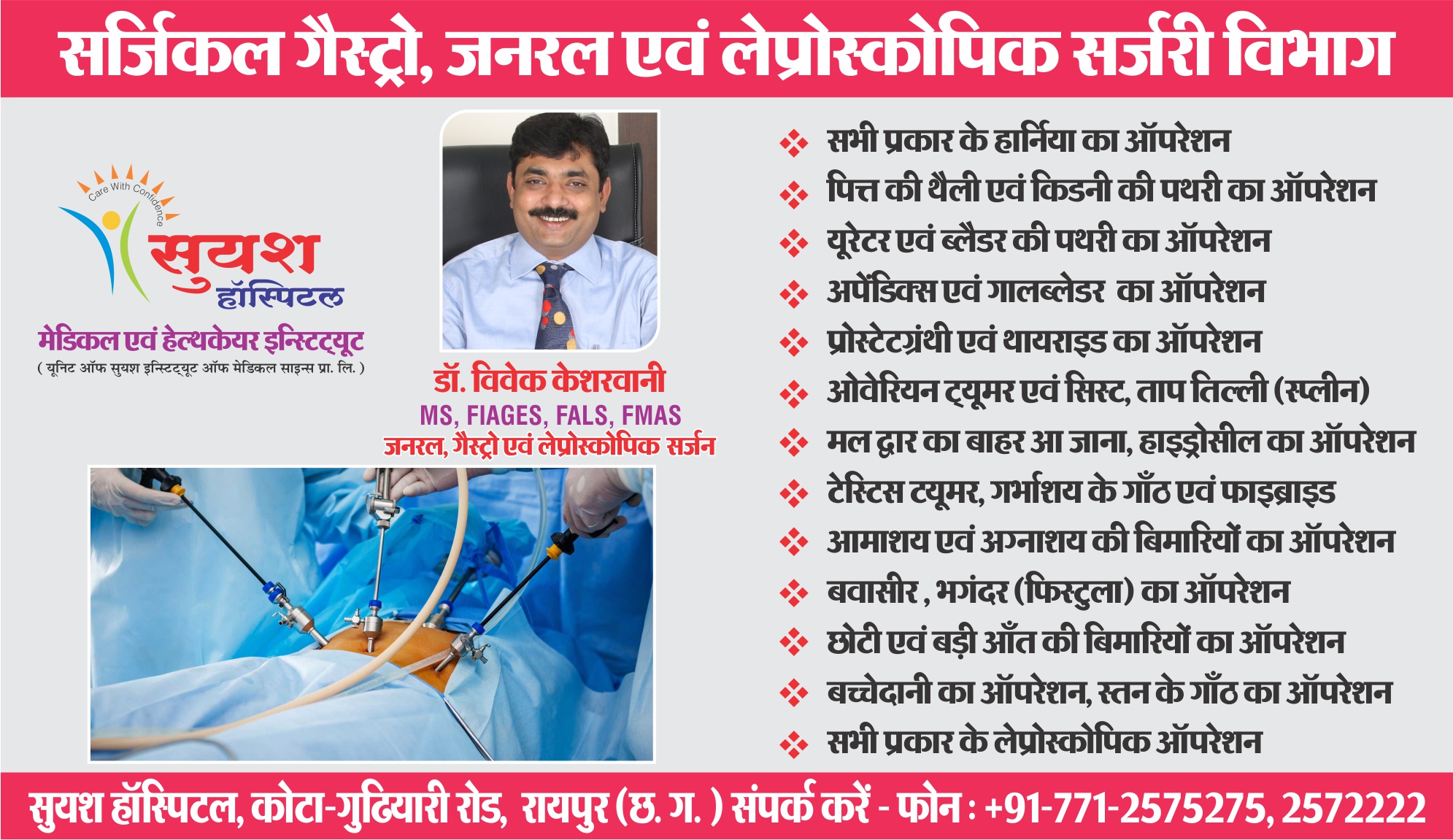Suyash Hospitals' skilled surgeons are experts in the field of minimally invasive and laparoscopic surgery. Offering laparoscopic procedures, our surgeons have been at the forefront of adopting new technologies to provide comfortable, painless, and accurate diagnosis and treatment. In addition to palliative care, Suyash Hospital's surgeons take a multidisciplinary approach to determine the cause of the conditions and identify methods to prevent future complications.
Laparoscopic Surgery
Laparoscopy is a surgical procedure performed through very small incisions in the abdomen, using specialized instruments. This type of surgery is also called minimally invasive surgery or keyhole surgery because of the very small incisions used. Yet major procedures can now be performed using this technique. In this procedure, a pencil-thin instrument called a laparoscope is used. A laparoscope has lenses like a telescope to magnify body structures, a powerful light to illuminate them, and a miniature video camera. The camera sends a magnified image from inside the body to a video monitor, giving the surgeon a close-up view of the organs and tissues. Specialized surgical instruments can be inserted through the laparoscope, and through small incisions nearby. These instruments serve as tiny hands within the abdomen and assist the surgeon. Laparoscopy is used either to treat the problem (laparoscopic surgery) or to diagnose it (diagnostic laparoscopy). With laparoscopy, the doctor can identify diseased organs, take tissue samples for biopsy, and remove abnormal growths.

Advantages of Laparoscopy Surgery
Despite small holes, there is no compromise in the field of vision. Much more of the insides can be seen than is possible at an open operation. Unlike the mini-incision operations, here the entire abdomen can be visualized ensuring no abnormal anatomy or pathology is missed. In the case of diagnostic laparoscopy, quick information is gained and the entire procedure can be recorded on video and further opinion can be taken from other surgeons in case of a diagnostic dilemma.
Laparoscopy is easier on the patient because it uses a few very small incisions. For example, traditional open surgery on the abdomen usually requires a four- to five-inch incision through layers of skin and muscle. In laparoscopic surgery, the doctor usually makes two to three incisions that are about a half-inch long. The smaller incisions cause less damage to body tissue, organs, and muscles. So the advantages of laparoscopy are:
»» Fast recovery
The patients can return to work much faster compared to the traditional open surgeries. The reason is that the damage to tissues and muscles is less because incisions made during laparoscopic procedures are very small.
»» Short hospital stay
Depending on the kind of surgery, patients may be able to return home a few hours after the operation, or after a brief stay in the hospital.
»» Less postoperative pain
The amount of discomfort varies with the kind of surgery. But the pain is much less compared to the open surgery. This is because, in laparoscopic surgeries, it is not required to cut the abdominal muscles. The laparoscopy surgeons just make tiny incisions for the instrument to go inside.
»» Better cosmetic results
The incisions for laparoscopic surgery are very small. So they heal without noticeable scars.
In today’s fast-moving world, our approach to healthcare is also rapidly changing. While diseases remain the same, we expect medical technology to help us more effectively. Research and Technology have obliged us with improved diagnostic tools, better medicines, and special surgical techniques. One such technique developed in digestive care is laparoscopic or minimal access surgery. Suyash Superspeciality Hospital provides advanced technology and instruments, a highly trained team of anesthetists, critical care, and high dependency units with a highly skilled intensivist and medical gastroenterologists to work along with minimal access surgeons.

Laparoscopic Surgery feature in Suyash Superspeciality Hopsital:
»» Diagnostic Laparoscopy
»» Laparoscopic Appendectomy
»» Laparoscopic Cholecystectomy (Removal of Gall Bladder)
»» Hernia surgery
»» Laparoscopic Splenectomy
»» Colorectal surgery
»» Gastric surgery
»» Total Laparoscopic Hysterectomy
»» Laparoscopic oophorectomy
»» Laparoscopic Ventral/Incisional Hernias
»» Laparoscopic Perforation Repair
»» Laparoscopic Liver Abcess / cyst
»» Hepatobiliary surgery
»» Pancreatic surgery
